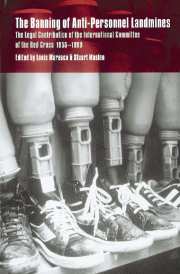 The Banning of Anti-Personnel Landmines
The Banning of Anti-Personnel Landmines Book contents
- Frontmatter
- Contents
- Foreword by Cornelio Sommaruga, President, International Committee of the Red Cross
- Foreword by Ambassador Jacob S. Selebi, South Africa
- Foreword by Ambassador Johan Molander, Sweden
- Introduction
- PART 1 FROM PRINCIPLES TO RULES: REGULATING MINES UP TO THE 1980 CONVENTION ON CERTAIN CONVENTIONAL WEAPONS
- PART 2 THE REVIEW CONFERENCE OF THE 1980 CONVENTION ON CERTAIN CONVENTIONAL WEAPONS: AN INITIAL RESPONSE TO THE LANDMINE CRISIS
- PART 3 THE OTTAWA PROCESS FROM REGIONAL INITIATIVES TO AN INTERNATIONAL PROHIBITION OF ANTI-PERSONNEL MINES
- Index
Foreword by Ambassador Johan Molander, Sweden
Published online by Cambridge University Press: 03 December 2009
- Frontmatter
- Contents
- Foreword by Cornelio Sommaruga, President, International Committee of the Red Cross
- Foreword by Ambassador Jacob S. Selebi, South Africa
- Foreword by Ambassador Johan Molander, Sweden
- Introduction
- PART 1 FROM PRINCIPLES TO RULES: REGULATING MINES UP TO THE 1980 CONVENTION ON CERTAIN CONVENTIONAL WEAPONS
- PART 2 THE REVIEW CONFERENCE OF THE 1980 CONVENTION ON CERTAIN CONVENTIONAL WEAPONS: AN INITIAL RESPONSE TO THE LANDMINE CRISIS
- PART 3 THE OTTAWA PROCESS FROM REGIONAL INITIATIVES TO AN INTERNATIONAL PROHIBITION OF ANTI-PERSONNEL MINES
- Index
Summary
Fourteen years after its adoption, preparations began for the First Review Conference of the 1980 Convention on Prohibitions or Restrictions on the Use of Certain Conventional Weapons Which May be Deemed to be Excessively Injurious or to Have Indiscriminate Effects (CCW) and, in particular, its Protocol II on Landmines. Governments approached the subject matter warily. At the very outset, few proposals for amendments were made – and they were modest at best. Generally, governments considered the Protocol a good treaty text. The problem was rather insufficient adherence and lack of implementation. Not until the third meeting of the preparatory Group of Governmental Experts did one country (Sweden) formally submit a proposal for a ban on the use of anti-personnel mines.
However, the cumbersome diplomatic process, based on universality and consensus, set in motion a chain reaction that was difficult to foresee. It created the ideal focal point for the international efforts to ban landmines. The haggling over seemingly unimportant details and procedure in comfortable Geneva, on one hand, and the nameless suffering of children, women and men torn to pieces by the hidden killers in the rice paddies of Cambodia, the valleys of Afghanistan or the fields of Angola, on the other – this contrast was too stark, too brutal not to bring home the message to millions around the globe that anti-personnel mines represent an evil that must be stopped.
The complications of the review process grew. Some mine-using and mine-producing countries stiffened their resolve to make only concessions that would be compatible with continued routine use of anti-personnel mines, at least in international conflicts.
- Type
- Chapter
- Information
- The Banning of Anti-Personnel LandminesThe Legal Contribution of the International Committee of the Red Cross 1955–1999, pp. xxiii - xxviiiPublisher: Cambridge University PressPrint publication year: 2000


